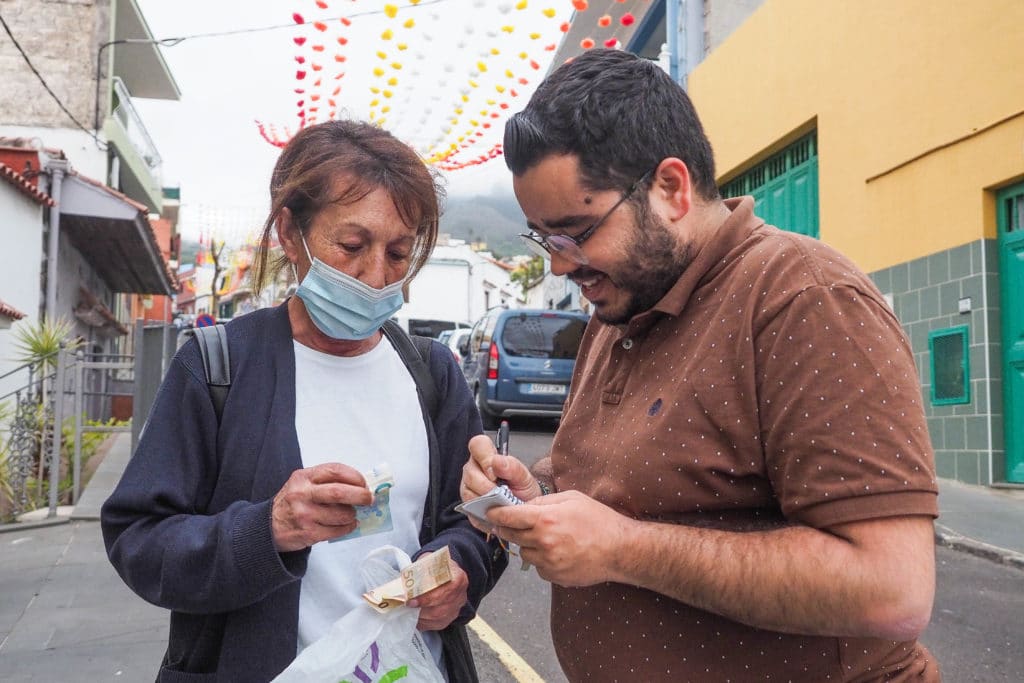
Yaya, Lola and Carmen Luisa arrive on time for the appointment in the chapel. Later, other residents of El Medio street join in to finish organizing the preparations for the Fiestas de las Cruces y Fuegos de Mayo, which this year is expected with more fervor and desire than ever because they are celebrated on the street again after two years. of pandemic.
In parallel, on El Sol street, Mari Negrín and Jacob Expósito, go knocking on doors to ask for ‘the dogs of the cross’. She keeps the money she collects in a small plastic bag while he writes down the contributions and the names of the neighbors who collaborate, which are the vast majority, in a notebook.
The same thing that Lola does, although in a larger notebook.
The truth is that in Los Realejos anything goes to get the money to cover the expenses of this celebration, a job in which the residents of both neighborhoods are involved, regardless of age or gender.
The two neighborhoods have already adorned their streets with colored paper flowers and are preparing to enjoy today the big day of the festivities with the pique of fireworks and flowers, the fireworks and the decorated crosses throughout the municipality, although yesterday , in the center of the Holy Cross, many families opened the patios of their houses so that the public can visit the decorated logs, a hallmark that has been passed down from generation to generation for more than three centuries.
‘The dogs for the cross’ are also a sign of identity in which children and adults are involved, even in post-war times and despite poverty, they “searched even under the stones to maintain the pique between the two streets and fulfill the promises made to the cross”, wrote the realejero historian Álvaro Hernández Díaz in a review in the Facebook group ‘Anecdotes and characters of the realejero May’, in which he notes that “the residents of these two streets have always sharpened the ingenuity so that each year the dogs of the Cross would not be lacking. Pigs were raised that were later auctioned, the women cut tablecloths that were sold in the town or in the streets of the then thriving Puerto de la Cruz. The kids were the most ingenious, they participated in everything, and some even raised a foal that was later sold at the cattle fair.”
He even says that on one occasion “a neighbor, who bought a beautiful hen for fifteen pesetas, got two thousand! with the broth that he made with her, and he even had the audacity to auction off the remains, thus considerably increasing the number of ‘bitches for the Cross’.
A year before confinement, Lola and her partner Milagros, who always go out together to beg, “got almost a million pesetas,” Carmen Luisa points out. “Always ask, ask, I love to ask for the dog”, confesses Lola. Her classmates say that she has “a lot of art” for that and she humbly believes that “they don’t do it so badly” despite her 79 years.
The people gladly wait for them, and in the same way they give them the money because “it is a joy” to collaborate for the cross. There are also people who say that “there is no money” and that “things are very bad”, but in general, “if there are not five, there are ten and if not twenty, each one gives what he can”.
Mari and Jacob confirm the same thing: “each one contributes according to their possibilities, because there are families who want but cannot give everything they would like”.
Mari doesn’t remember when she started collecting ‘the little dogs for the cross’. She does it by family tradition. “It costs a lot, you have to walk a lot, knock on many doors, because people get upset if we don’t go through their houses, each one gives their will and that’s how we get the parties going,” he says.
It is a year-round job in which the residents of the two streets get involved in different ways, either collaborating or going out to ask. And although the purpose is the same, the parties, have always been two separate accounts, that of the flowers, which women used to and are usually in charge of, and that of the fires, men. In recent years, this organization “has broken the mold, because I’m a boy and I ask for flowers,” explains Jacob.
However, ‘the bitches’ are not the only way to raise money for the festivities. They also organize excursions, sell raffles, lottery numbers and the stalls, which premiere this Saturday at the festival ‘Los realejeros cantan a su pueblo’ and are usually attended by men while women collaborate with food or preparing the snacks.
Formerly, on El Medio street, ‘the dog’ for the cross was asked for every Sunday, points out Carmen Luisa. There was a tin box and when the collection was finished, the neighbors who took care of this task took it to Doña María ‘la Caracas’, a lady who lived in the neighborhood and who kept it every year without even counting it. At the last minute she would take it out and confirm how much she had. A custom that was lost because the lady was getting older.
The truth is that the involvement of the residents of both streets for the Fiestas de Mayo is unquestionable and that will be demonstrated again today, although again it will be difficult to know which of the two has won this year’s ‘war’ of fireworks and flowers.
















